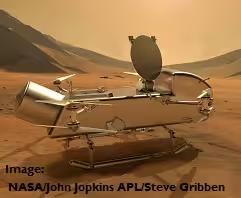Exploring Saturn's moon - TITAN
Saturn's moon TITAN has lakes, seas and mountains. Not much was known about this hazy moon, covered by a dense atmosphere. In 2004, the Cassini - Huygens spacecraft revealed hydrocarbons, weather patterns and seasonal rains. TITAN has a striking resemblance to Earth.

Saturn is famous for its rings. Do you know it is also famous for its moons ?
Saturn has an whooping 146 moons (what we have counted so far) around it. Largest of them is Titan and it is bigger in size than our moon.
Titan has a thick atmosphere blocking the planet completely. It is impossible to study it from Earth using telescopes.
TITAN discovery
Way back in 2005, Cassini spacecraft flew to Titan and spent many years exploring it. It showed a fascinating landscape. Atmosphere on Titan is rich in nitrogen gas, similar to our atmosphere on Earth. There are lakes, deep seas and rain clouds on Titan, but they do not have water. Cassini figured out the liquid in Titan's lakes and seas are liquid hydrocarbons, like methane or ethane. TITAN has a methane cycle similar to Earth's water cycle.
Water on TITAN
Not that TITAN has no water... A huge ocean of liquid water lies trapped under its surface. This ocean has real water, mixed with ammonia.
Why is NASA interested in TITAN
Cassini's data shows chemical composition on Titan is suitable for life. There is a fair chance that microscopic life (like bacteria or planktons) already exists on Titan, or may evolve in the near future. This makes Titan the best target for NASA's New Horizons space programme. It includes space missions to parts of the solar system with traces of chemicals needed for life to exist
Dragonfly Spacecraft
Dragonfly is a space craft under construction by NASA as part of the New Horizons program, designed to explore TITAN. This space craft is named the dragonfly because it can travel by land and air on Titan. It is designed as a rover that can transform in to a flying drone. It is a rover-craft.
It will explore everything on Titan from seas to volcanoes. It is designed to collect samples of rocks and soil, study its chemical composition to detect water based or hydrocarbon based living organisms.
Meterology instruments on Dragonfly will study seismic movements below the surface, collecting data about the underground ocean. Images sent by its cameras are much awaited as it will show us how Titan's landforms look.
This quadcopter cum drone is scheduled to be launched in 2027, and will land on Ttan in 2033.
Click here to visit the official website of Dragonfly space mission.
